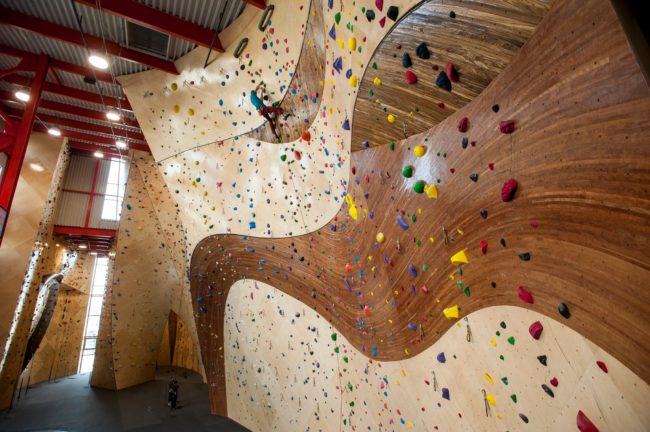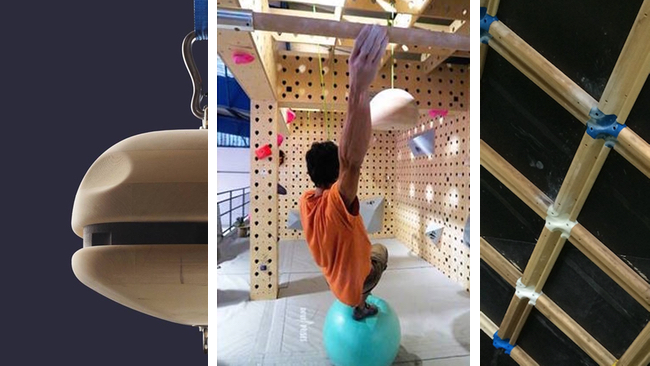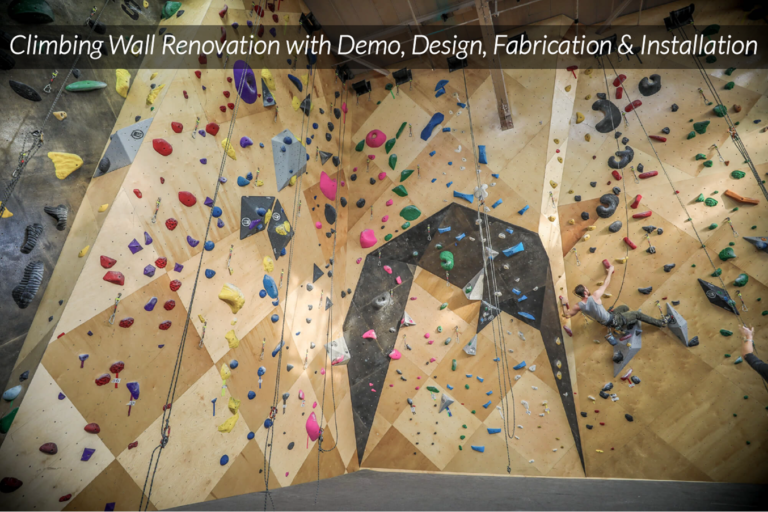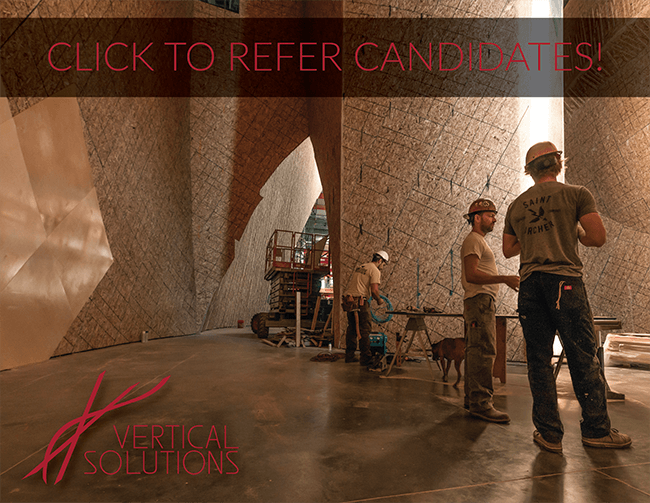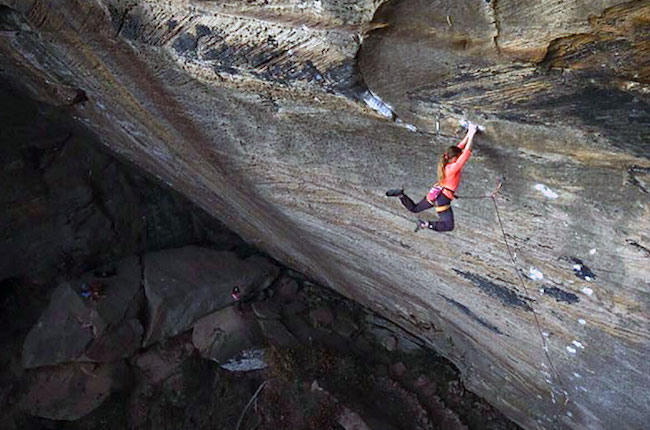Tech Brings Crag To Gym
Through a combination of 3D modeling, digital fabrication, and other techniques, a Dartmouth-led research team has succeeded in replicating sections of outdoor rock climbing routes on an indoor climbing wall.
All of this was done in an effort to “Research environment-scale fabrication as well as measuring and replicating friction properties of natural materials, and studying the biomechanics of human locomotion in challenging conditions,” the authors of the study wrote.
They also noted that “Outdoor climbing areas are usually scarce and fragile and their extensive use for sport or recreational purposes represents environmental concerns.” As more climbers enter the sport their presence at outdoor crags is having an impact on those environments. “We believe that replicating outdoor routes could impact the indoor climbing gym industry and inspire future research in environment-scale fabrication as well as related scientific and technological questions.” This might be true but if the technology is widely adopted it could have a bigger impact on the outdoor scene.
UK’s Tallest Wall Opens
Grain silos have been repurposed into climbing gyms for decades here in North America. Now the UK gets in on the action with the new Roktface at ROKT climbing center in Brighouse, West Yorkshire which is just southwest of Leeds.
Billed as the “highest man-made outdoor climbing wall” in the UK, the silos are 36 meters (118 feet) tall. The £75,000 ($97,000) project is a partnership between the climbing center and the local Calderdale Council.
Just don't look down… ????
Posted by BBC Look North (Yorkshire) on Monday, May 8, 2017
Next Gen Climber Training Tools
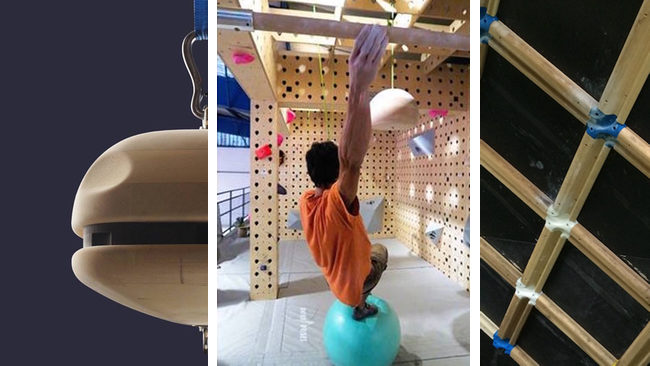 For years the hangboard reined supreme in the climbing training realm, but now campus and systems boards are commonplace along with entire hangboard centers coupled with rings, hang balls and TRX. Not only are operators installing these amenities they are offering classes in how to use them, effectively doubling down on their investment.
As training areas become essential elements of good gym design, gear companies have stepped up to fill this burgeoning need with innovative products. With so many options now on the market, we give you a look at just a few of the new and innovative equipment on the market that is making its way into climbing gyms.
For years the hangboard reined supreme in the climbing training realm, but now campus and systems boards are commonplace along with entire hangboard centers coupled with rings, hang balls and TRX. Not only are operators installing these amenities they are offering classes in how to use them, effectively doubling down on their investment.
As training areas become essential elements of good gym design, gear companies have stepped up to fill this burgeoning need with innovative products. With so many options now on the market, we give you a look at just a few of the new and innovative equipment on the market that is making its way into climbing gyms.
The Yoak
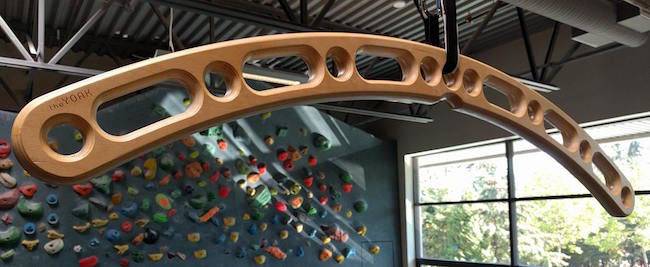
Lattice Board
Because of the irregular nature and difficulty of routes and boulder problems, it can be difficult to create a baseline in which to compare performance. Climbing is not track & field! It’s equally as hard to know what training techniques aided the climber in their success. In fact, far too often the actual effectiveness of training programs goes unmeasured. The Lattice board hopes to solve that problem by creating a true systems wall that allows for actual movement. The board is a new breed of training device that combines analytical performance assessment with actual training programs. First developed by UK crack sleigher Tom Randall to assess pro climbers competing on the international stage, the Lattice board quantifiably tells you whether what you’re doing is actually working. For gyms or competitive teams that are serious about quantifying their teaching methods and producing medal collecting athletes, The Lattice Board is made for you. Because the board requires a fair bit of instruction and learning to use correctly, Randall and his team have created a slew of assessment and training tools that you can do via the internet. They also have online coaches that can perform assessments. Now, all it needs is an app! Lattice is slowly making a show in US climbing facilities. Currently being installed at The Crux in Austin, Texas and LEF in Lexington, Kentucky.Monkey Space
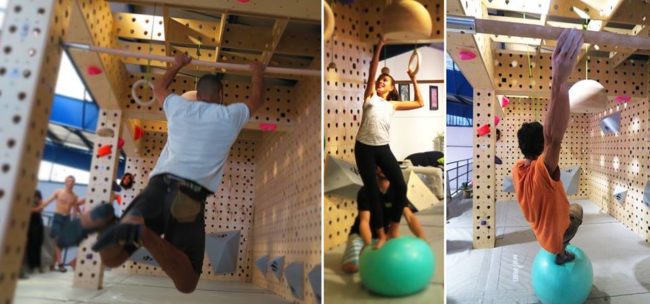
Climbing Burger
Hanging from objects is so simple and honestly a little one dimensional. Enter the Climbing Burger from Antworks. An innovative twist on the hanging “giant ball” sloper, the Burger takes it to a new level with multiple grip surfaces combined with multiple hand positions all while trying to maintain stability. The Burger could bring some fun back into your team’s training regimen!“The Valley” Plants Flag in S. Denver
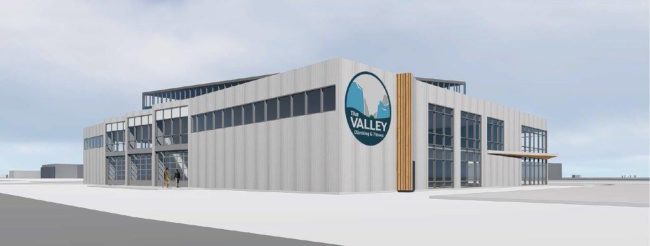
Vertical Solutions’ Case Study: Brooklyn Boulders
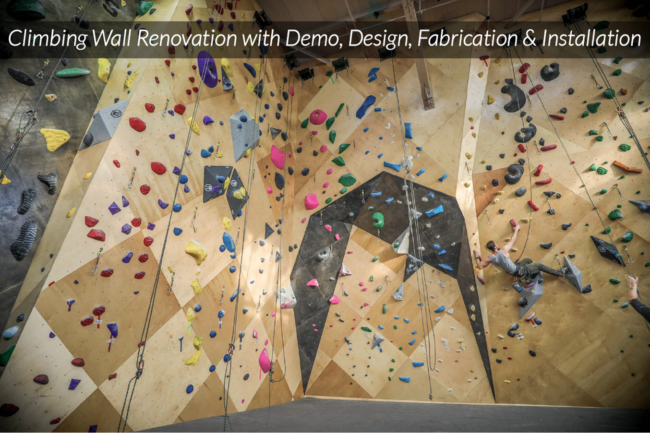
Problem
Brooklyn Boulders, one of the nation’s leading indoor climbing facilities, planted their roots in the Gowanus neighborhood of Brooklyn back in 2009. With a massive plan to rock the climbing world, they set out with a fantastic space, a vision, and their own grassroots construction methods and materials. What they didn’t know right away, was how quickly their brand would expand to facilities in Chicago, Boston and into the next borough north, Queens. Their first facility that garnered so much attention, was built to suit the times as proving a business model around indoor rock climbing in New York City at the time was uncharted territory for the BKB crew. They used very traditional steel tube and plywood material construction, along with surface treatments that could easily be acquired by your typical home-construction enthusiast. During the process, the designs were often created on-the-fly with construction starting before concepts were fully completed. Again, this was the very first facility of its kind in Brooklyn, and the goals were to get up and operational quickly on a grassroots budget. The BKB founders didn’t have the luxury of committing to a large-scale climbing wall builder for designs and manufacturing. Subsequent to the unparalleled success of the BKB Gowanus location, the owners knew they had something bigger on their hands than simply one amazing climbing facility: They had built a proper indoor climbing brand that could expand to bring together urban climbing enthusiasts in other major metropolitan areas. So when the time came to expand to other Top 10 DMAs, the team at BKB already had their model for success, but now they had the luxury of creating their own modern, design-driven dream facility using the latest in climbing wall construction and aesthetics from Vertical Solutions. Brooklyn Boulders and Vertical Solutions teamed up to expand the BKB brand to three additional facilities in Boston, Chicago, and another in NYC: Long Island City in Queens.
Seven years after their initial opening in Brooklyn, they had four stunning facilities on their hands, and one major problem: their owner-built walls at the Gowanus location were tired and out-of-date. They served their purpose for many years but they no longer aligned with the BKB image of top-tier quality climbing, unique experiences focused on outdoor enthusiasts, and seamless branding from one facility to the next. Additional complexities were introduced due to more than expected maintenance as a consequence of age and construction method. So the BKB team once again pushed for a new step forward: Major reconstruction on a significant percentage of their climbing walls.
In cities like NYC, space is not only hard to come by, but also at a major premium. The team wouldn’t consider closing their entire facility down for these much needed renovations, coming into the busiest time of year: the winter holiday season. Closing their doors to their large membership for weeks on end was simply not an option. They needed a solution that was equally stunning as their other facilities, adaptable to open conditions, would last much longer than their previous owner-built solutions, and most importantly: they needed it fast.
Subsequent to the unparalleled success of the BKB Gowanus location, the owners knew they had something bigger on their hands than simply one amazing climbing facility: They had built a proper indoor climbing brand that could expand to bring together urban climbing enthusiasts in other major metropolitan areas. So when the time came to expand to other Top 10 DMAs, the team at BKB already had their model for success, but now they had the luxury of creating their own modern, design-driven dream facility using the latest in climbing wall construction and aesthetics from Vertical Solutions. Brooklyn Boulders and Vertical Solutions teamed up to expand the BKB brand to three additional facilities in Boston, Chicago, and another in NYC: Long Island City in Queens.
Seven years after their initial opening in Brooklyn, they had four stunning facilities on their hands, and one major problem: their owner-built walls at the Gowanus location were tired and out-of-date. They served their purpose for many years but they no longer aligned with the BKB image of top-tier quality climbing, unique experiences focused on outdoor enthusiasts, and seamless branding from one facility to the next. Additional complexities were introduced due to more than expected maintenance as a consequence of age and construction method. So the BKB team once again pushed for a new step forward: Major reconstruction on a significant percentage of their climbing walls.
In cities like NYC, space is not only hard to come by, but also at a major premium. The team wouldn’t consider closing their entire facility down for these much needed renovations, coming into the busiest time of year: the winter holiday season. Closing their doors to their large membership for weeks on end was simply not an option. They needed a solution that was equally stunning as their other facilities, adaptable to open conditions, would last much longer than their previous owner-built solutions, and most importantly: they needed it fast.
Click to go straight to the BKB Project Gallery
Options
Time is of the essence. As a business operating in 3 major markets, they were targeting some major new goals for 2017. Those goals, couldn’t afford a “pause” on the profitability of their facility in Brooklyn. They had to hit the ground running absolutely as soon as possible to meet those goals, and it demanded an accelerated completion date with work done in a compressed timeframe. Design, engineering, demolition of the owner-built walls, construction and installation; all in 9 weeks from project launch. To complicate the whole project, the work all had to be done over Thanksgiving week, Christmas week, and New Years week, while the facility was open, in the logistically-difficult construction environment of New York City. Brooklyn Boulders could choose any climbing wall builder in the market, despite their previous experience using Vertical Solutions. However, as defined by the problem, they could not seek any alternative options that: -did not have experience navigating the NYC construction logistics -could not mobilize quickly -did not have an expedited manufacturing process -did not have an efficient design construction style ready to deploy -needed more time to complete than identified by the goals -required the facility to close during construction -had any objections to working over major holiday weeks Before pictures: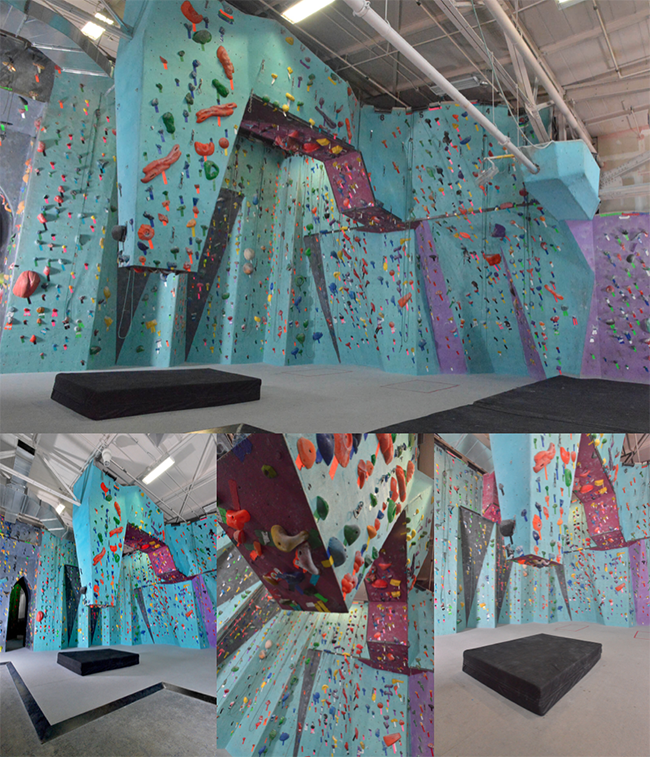
Solution
Vertical Solutions was selected as the only company that could meet or exceed all of the identified objectives. The design team only had 3 weeks to design and fully engineer 5000 square feet of rope climbing walls; a task usually coming in over twice the allocated timeframe (7 weeks typically). In order to accomplish this, considerations for the wall design style had to be made to match the project. Vertical Solutions relied on their extremely agile, accurate, and adaptable construction method of choice: The new MLM wall construction process utilizing wood CNC machine production panels. This method, which expedites pre-fabrication at HQ in Salt Lake City, delivers a product guaranteed to fit onsite with minimal re-work. The talented design team took to task, and crushed the design process with geometric-shaped panels seamlessly joined to create modern and stunningly-aesthetic wall surfaces. Even harder to believe is the fact that this project wasn’t a clean sheet build from the ground up. The Vertical Solutions team was required to demolition the old owner-built wall square footage immediately to keep on schedule, and work within the massively tight constraints and logistics of New York City. After pictures: Head over to the VS Gallery Page for more images of the full gym and renovations.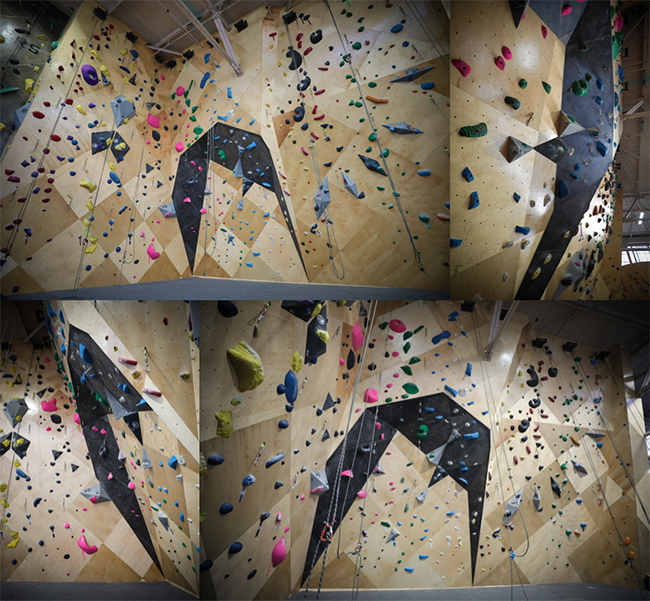
Results
The Vertical Solutions team stepped up to tackle this unbelievably large project for the allocated timeframe. From conception, the existing owner-built walls were demoed, new MLM geometric walls were designed, engineered, constructed, shipped, and installed in a timeframe never before met in the busiest metropolitan area in the US. This case study has set a new standard for accelerated and impactful climbing wall construction. Vertical Solutions delivered all of the following: -a retrofit project to replace current aging owner/home-built walls to keep up with modern built facilities -a project completed extremely fast and on-schedule, over three major holiday weeks -a project completed on-budget -a project to not affecting a facility closure to keep the clientele climbing -a project using an expedited, reliable, and durable construction style This proof of concept executed on behalf of Brooklyn Boulders, illustrates that when a climbing facility needs any of those deliverables, or even all of them at once, Vertical Solutions has the team, expertise, tools and ambition necessary to meet them. Customer Testimonial: Lance Pinn, President, Brooklyn Boulders “As usual, we put some very tight and non-negotiable constrains on the project scope that we gave to Vertical Solutions. Additionally, this recent renovation project was by far the most accelerated we’ve ever proposed. The fact that all of this came together and was installed over the holidays without closing our facility was nothing short of monumental. This is New York; nothing closes! I don’t want to overlook the importance of this project’s design either. We’d¬¬ built a brand that requires cohesion amongst all the facilities and we couldn’t accept anything that wasn’t spectacular and immediately impressive, yet tailored to the Brooklyn audience. The design team worked with us quickly to get us something fresh and new, with durability being a major priority. We can’t imagine choosing any other wall builder to get this done right and on-time.” To learn more about Brooklyn Boulders’ multiple climbing facilities head over to their website. To learn more about Vertical Solutions products and services for climbing gym walls, floors or holds, visit their new website or email sales@verticalsolns.com.This story was paid for and produced by the sponsor and does not necessarily represent the views of the Climbing Business Journal editorial team.
Earth Treks To Build US’s Largest Gym
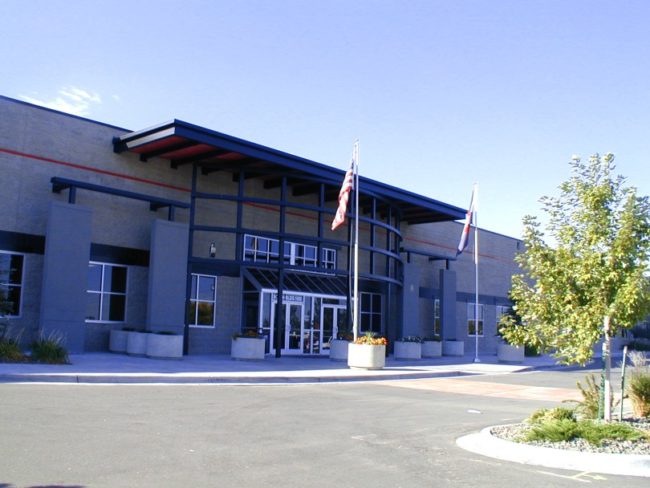
Vertical Solutions’ New Hiring Bonus
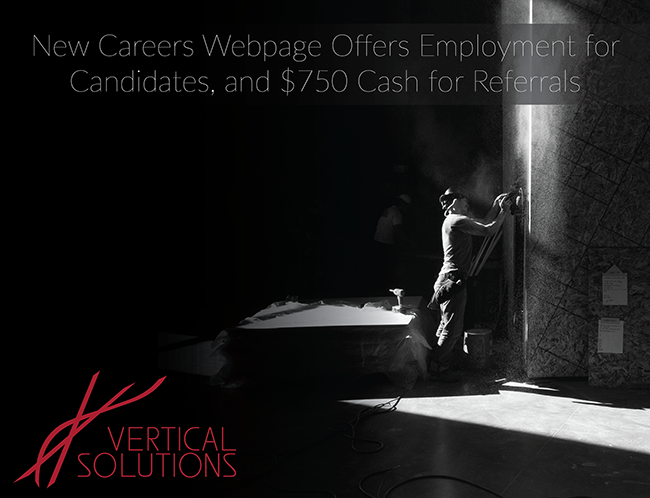 Vertical Solutions, the nation’s leading one-stop solution provider for indoor climbing walls, floors, holds, and business consulting, is launching a new industry referral program to aide the expansion of their climbing wall construction crews. Manufacturing climbing products and building climbing gyms requires that employees not only posses job-specific skills, but also satisfy the right mindset and culture-fit to successfully fill roles. The specialization of the climbing gym business lends itself to employees that have an intimate passion to match their abilities, and Vertical Solutions has no shortage of opportunities available for candidates matching that description, with a full schedule already set for 2017 going well into 2018.
Historically, Vertical Solutions has had the majority of their most tenured employees referred by the climbing industry professional network, or cultivated through climbing gym employment or membership. The ability to incorporate an enthusiasm for the outdoor industry into a career building climbing gyms is integral to contribute to Vertical Solutions’ company goals. As a result, this is often rewarded during the hiring process by the referred candidate being given preferential treatment during the interview process. That reward is now extending to the referring individual, by way of a $750 cash bonus. The referring individual of a new-hire will receive a $500 bonus after their referral’s employment for 30 days. An additional $250 will be rewarded to the referrer for that same employee’s tenure after 180 days. This $750 total reward for new-hire referrals is intending to not only sustain but amplify the preferential treatment of deserving individuals already part of the climbing business community. Vertical Solutions is a community-focused organization, and believes in rewarding others with similar motivations.
If you or a colleague knows a passionate community member looking to start or continue a career in the climbing industry, you should reach out immediately to Vertical Solutions by visiting the Vertical Solutions Careers Homepage. There, you can see available positions and forward the link to the candidate in question. All the candidate needs to do is reference your name and email address in the “Leave A Comment” text block, and your information will be linked with his/her application in our system. If you are interested in applying directly to Vertical Solutions, use the Careers Homepage to select a position and fill out the application. We are genuinely appreciative of every candidate that is considering a career at Vertical Solutions!
We want to hear from you if you are considering a career in the climbing community! Check out what you could be working on at VSClimbingGyms.com.
Vertical Solutions, the nation’s leading one-stop solution provider for indoor climbing walls, floors, holds, and business consulting, is launching a new industry referral program to aide the expansion of their climbing wall construction crews. Manufacturing climbing products and building climbing gyms requires that employees not only posses job-specific skills, but also satisfy the right mindset and culture-fit to successfully fill roles. The specialization of the climbing gym business lends itself to employees that have an intimate passion to match their abilities, and Vertical Solutions has no shortage of opportunities available for candidates matching that description, with a full schedule already set for 2017 going well into 2018.
Historically, Vertical Solutions has had the majority of their most tenured employees referred by the climbing industry professional network, or cultivated through climbing gym employment or membership. The ability to incorporate an enthusiasm for the outdoor industry into a career building climbing gyms is integral to contribute to Vertical Solutions’ company goals. As a result, this is often rewarded during the hiring process by the referred candidate being given preferential treatment during the interview process. That reward is now extending to the referring individual, by way of a $750 cash bonus. The referring individual of a new-hire will receive a $500 bonus after their referral’s employment for 30 days. An additional $250 will be rewarded to the referrer for that same employee’s tenure after 180 days. This $750 total reward for new-hire referrals is intending to not only sustain but amplify the preferential treatment of deserving individuals already part of the climbing business community. Vertical Solutions is a community-focused organization, and believes in rewarding others with similar motivations.
If you or a colleague knows a passionate community member looking to start or continue a career in the climbing industry, you should reach out immediately to Vertical Solutions by visiting the Vertical Solutions Careers Homepage. There, you can see available positions and forward the link to the candidate in question. All the candidate needs to do is reference your name and email address in the “Leave A Comment” text block, and your information will be linked with his/her application in our system. If you are interested in applying directly to Vertical Solutions, use the Careers Homepage to select a position and fill out the application. We are genuinely appreciative of every candidate that is considering a career at Vertical Solutions!
We want to hear from you if you are considering a career in the climbing community! Check out what you could be working on at VSClimbingGyms.com.
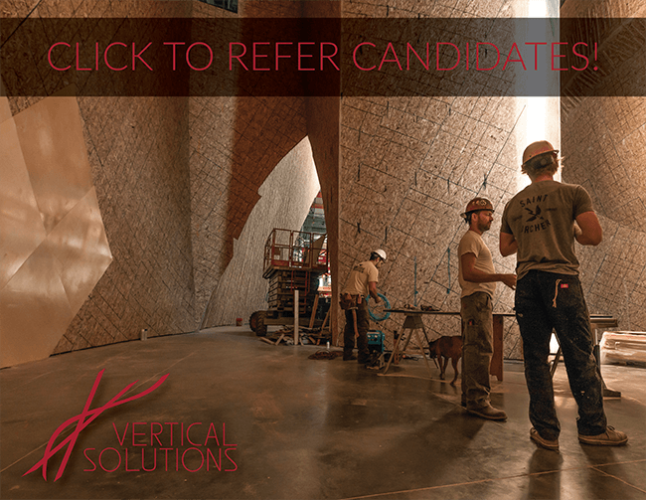
This story was paid for and produced by the sponsor and does not necessarily represent the views of the Climbing Business Journal editorial team.
The Cost of Free Video
By Richard Evans
Most of us will never feel the rush of redpointing a 5.14c, but climbing videos bring us along for the ride to the top. For the filmmakers, that ride isn’t cheap. Multiple trips to the crag, drone operators, park permits, writers, insurance and lightweight video equipment all raise costs in an era when viewers expect to watch great climbing footage for free on video sharing and social media websites. With all the free footage, it can be tough for filmmakers to turn a profit.
It’s really difficult, according to Pete Mortimer, co-founder of Sender Films. Sender Films, a nearly 20-year-old company, has produced many documentary climbing films from the early climbing classic, “Front Range Freaks” to “Valley Uprising,” which is available on Netflix.
“It’s a tough business, but there is a hunger out there for good content. In many ways, we are living in the golden age of video as there are so many outlets for video content now, from Apple TV to YouTube to brand channels. Companies like Netflix are trying to get subscribers by creating original shows and by buying fresh content, and they are spending billions of dollars a year. Meanwhile, the traditional advertisers want to support video projects and create their own channels, and there are more avenues than ever for video content now, but it’s still a tough business and hard to create valuable content,” he said.
That sentiment is echoed by Jeff Davidson, vice president of marketing for Skratch Labs. “The sponsors are all dying for content so what ends up happening is that regardless of how much money is being asked of the sponsor, the sponsors are asking for more from the filmmakers and the sponsors can use that content in a lot of different places.”
Skratch Labs makes performance food and drinks and partly funded the documentary video of the first female, Michaela Kiersch, to send The Golden Ticket (5.14c). That video, “The First Female Ascent of The Golden Ticket,” was produced by Andy Wickstrom, and Gabi and Brandon Fox.
The Long and Short
“For Michaela’s film, we knew the documentary would be about 15 minutes long. In this day and age that’s long when it is online, so we asked for a 30-second version and multiple 10-second versions so we could use the same content in six different channels. As a nutrition company, rather than a climbing gear company, we also asked for rights to the B-roll so we could show the energy it takes to climb like that,” Davidson said. With rights to the B-roll (supplemental footage), Skratch Labs could hire their own video editor to make videos about how its products help climbers. Sometimes, those rights come with restrictions on the length of the video made from the supplemental footage. The filmmaker takes the footage he or she has rights to and then packages the video for different outlets. That way, the film is funded part by the sponsors and in part by viewers downloading the film, or by subscription outlets. “The focal point was selling DVDs when we started and now that has fallen away to selling transactional videos online like download, rentals or streaming, and a lot has been lost to piracy,” Mortimer said.Passion Projects
Under a different business model, some big companies pay for films outright. Well-heeled sponsors like Red Bull, The North Face, Patagonia, and so on, hire filmmakers to produce films starring their athletes. These sponsors keep all the rights to the footage, but the filmmakers do get credit for the film and the creative decision making. Sender Films, one of the more establishing production companies, operates under both of these models, and uses the Reel Rock tour, which has over 500 screenings nationwide, as a distribution mechanism for films that they own rights to. Reel Rock also works with other filmmakers to get good films on tour. Some of those films fall into a third business model: the passion project. These videos often stem from close relationships between filmmakers and pro climbers and get made with modest funding. The film in an investment in the pro’s brand and a showcase of the filmmaker’s creative and technical skills, but is often not financially profitable. Michaela Kiersch’s “Golden Ticket” video was a passion project, initiated by Kiersch and Wickstrom. “I approached my sponsors with the idea and proposed different budgets for them in exchange for product and logo placements. I didn’t take any of the cash, it all went to the editing because I already get paid to be an athlete for them and my expenses to go to the Red were covered,” Kiersch said. The Golden Ticket (5.14c) is in Kentucky’s Red River Gorge, known as “the Red.” Nearly everyone donates his or her time in for a passion project. Brandon Fox, one of “Golden Ticket’s” filmmakers said, “If we were charging day rates or hourly rates like we do with other video projects it didn’t cover near what it would actually cost, but we enjoy making these videos and knew that it would be a great story. We’re not coming away rich from it.” Brandon and Gabi Fox support their passion projects with their photography business, Foxes Photography, and by Just Go Climb, a company that produces shorter commercial videos, or brand pieces. Examples of this kind of film are their three-and-a-half minute videos “The Woodshed of Rockstar Volumes,” and “Tony at the Rubber Room.” Funding passion projects through other means is common; Kiersch is a climbing coach as well as a pro.The Pros
“It’s tough to make a full-time business out of it,” Brandon said about entering the climbing-film documentary business. “Getting funding on board is the most difficult thing and the biggest barrier to making more really awesome climbing videos.” One link to funding is through the pro climbers and their connections to sponsors. The pros are the stars of these films and often have a significant amount of creative say in the way film portrays them. It is absolutely critical for pros to protect his or her own brand image. For example, some pro climbers might ask that footage of them swearing after a fall be cut from a film, others might prefer that it be left in. “When I promote my personal brand it’s also promoting the sponsor’s brand. Being a professional athlete is just a marketing game. It’s about how many people you can influence to buy a certain product. Part of our job is to create content for the companies and promote the product so this [“Golden Ticket”] was that to an extreme,” Kiersch said. Over 100,000 online viewers have watched Kiersch send The Golden Ticket, endorsing her sponsors’ products. That’s just what the sponsors want. The sponsors need the pros and filmmakers to show products to viewers, the pros need the filmmakers and sponsors to get them in front of viewers, and the filmmakers need the sponsors and pros for stars and funding to make films. It’s a climbing love triangle that provides viewers with great content to watch on the way to the crag.The Front Could Nab Prime Spokane Location
